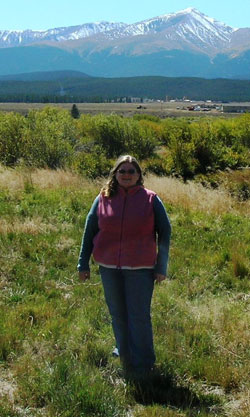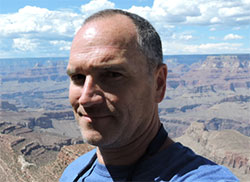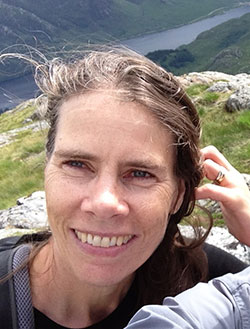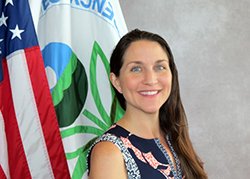Ecosystem Services Approaches and Tools for Contaminated Site Cleanup
Sponsored by: U.S. EPA, Office of Land and Emergency Management, Office of Superfund Remediation and Technology Innovation, Technology Innovation and Field Services Division
Archived: Tuesday, October 24, 2017
Ecosystem services are nature's contributions to human health and well-being. Examples include areas for outdoor recreation, pollination of food crops, and flood mitigation. In performing our work to protect the environment through contaminated site cleanup, we are learning that we also have the opportunity to protect and revitalize ecosystem services in a measurable way. Join us to learn about efforts by several EPA programs to understand how we may consider ecosystem services in managing contaminated site cleanups. This webinar presents an ecosystem services evaluation framework that resulted from a cross-EPA office collaboration, and summarizes how two quantitative evaluation tools, EPA EnviroAtlas and Service Providing Area (SPA) maps, were piloted at Superfund sites. You will also hear from Superfund site managers who will share insights on how they are considering ecosystem services during cleanup and are implementing innovative approaches for ecological revitalization at their sites. An understanding and quantification of ecosystem services may be helpful to ecological risk assessors and remediation project managers working on sites with existing ecosystems and/or sites with ecological reuse options.
Accessibility, Recording, and Content Disclaimer
Rehabilitation Act Notice for Reasonable Accommodation
It is EPA's policy to make reasonable accommodation to persons with disabilities wishing to participate in the agency's programs and activities, pursuant to the Rehabilitation Act of 1973, 29 U.S.C. 791. Any request for accommodation should be made to Michele Mahoney at 703-603-9057 or mahoney.michele@epa.gov, preferably one week or more in advance of the webinar, so that EPA will have sufficient time to process the request. EPA would welcome specific recommendations from requestors specifying the nature or type of accommodation needed. Please note that CLU-IN provides both alternate phone call-in options and closed captioning for all webinars, and requests for these specific accommodations are not necessary.
Webinar Recording
By participating in this CLU-IN webinar, you automatically agree to authorize recording of audio and visual content presented during this live event and consent to subsequent use of this recording in the public domain by the U.S. Environmental Protection Agency. This recording may include questions, comments and poll responses provided by you during the live event in addition to your name, voice, image or likeness. This recording will be made available after the conclusion of the live event as part of the CLU-IN webinar archives, and will remain available indefinitely. If you do not wish to consent to the recording, please do not join the live event, and contact Jean Balent at 202-566-0832 or balent.jean@epa.gov to discuss your concerns.
Content Disclaimer
This webinar is intended solely to provide information to the public. The views and opinions expressed as part of this webinar do not necessarily state or reflect those of the U.S. Environmental Protection Agency. It is not intended, nor can it be relied upon, to create any rights enforceable by any party in litigation with the United States, or to endorse the use of products or services provided by specific vendors. With respect to this webinar, neither the United States Government nor any of their employees, makes any warranty, express or implied, including the warranties of merchantability and fitness for a particular purpose, or assumes any legal liability or responsibility for the accuracy, completeness, or usefulness of any information, apparatus, product, or process disclosed, or represents that its use would not infringe privately owned rights.
Presenters:
 Jewel Lipps, Graduate Student at Georgetown University, former EPA Oak Ridge Institute of Science and Education Research Participant at EPA Technology Innovation and Field Services Division (el785@georgetown.edu)
Jewel Lipps, Graduate Student at Georgetown University, former EPA Oak Ridge Institute of Science and Education Research Participant at EPA Technology Innovation and Field Services Division (el785@georgetown.edu)
Jewel is a graduate student in the Biology Department at Georgetown University, where she researches the links between plant genetic diversity and restoration of ecosystem services. Through the Oak Ridge Institute of Science and Education, she held a two year research appointment at the EPA's Superfund Program headquarters. At EPA, she investigated newly developed tools and approaches for ecological revitalization and reuse of contaminated sites, and authored several reports, abstracts, and presentations on ecosystem services evaluations for cleanup projects. She also demonstrated the use of Story Maps for communication of Superfund case studies.
 Michele Mahoney, U.S. EPA Technology Innovation and Field Services Division (mahoney.michele@epa.gov or 703-603-9057)
Michele Mahoney, U.S. EPA Technology Innovation and Field Services Division (mahoney.michele@epa.gov or 703-603-9057)
Michele Mahoney is a Soil Scientist working on issues related to remediation and reuse of contaminated sites within EPA's Superfund program. In order to support practitioners, she researches and reports on knowledge related to treatment technologies for mining sites, use of soil amendments for remediation and redevelopment/reuse, ecological revitalization, ecosystem services, phytotechnologies, and urban gardening. Michele develops and delivers training for the world-renown EPA Clean-Up Information Network (www.cluin.org), particularly a Mining Webinar Series, and topics related to Superfund Redevelopment, Ecological Revitalization, Ecosystem Services, and Phytotechnologies. She also creates and manages content development for the EcoTools and Mining pages on CLU-IN.org.
Michele has worked with EPA for over 20 years. Prior to her current responsibilities, Michele served the Agency as the lead for food waste composting issues and as an environmental fate and ecological risk assessor for pesticide registration. Michele also has experience as a Contractor for EPA and a Laboratory and Field Researcher.
Michele earned a M.S. in Soil Science from the Washington State University, and a B.S. in Agronomy & Environmental Science from Delaware Valley University.
 Carlos Pachon, U.S. EPA Office of Superfund Remediation and Technology Innovation (pachon.carlos@epa.gov)
Carlos Pachon, U.S. EPA Office of Superfund Remediation and Technology Innovation (pachon.carlos@epa.gov)
Carlos manages EPA's Brownfields and Land Revitalization Technology Support Center which has an overall goal of advancing best practices and new technologies in cleaning up Brownfield sites. The Brownfields Road Map is a product of the BTSC, which in turn is a collaborative effort between the Superfund Program and the Office of Brownfields and Land Revitalization. Carlos has a broad cross-program perspective on innovative practices in site assessment and cleanup, and he generates and manages knowledge and information on the use of technologies in the Superfund Program. He is currently leading a cross-Agency effort to advance EPA's Principles for Green Remediation.
In recent years he has held other positions including Deputy Director for Environmental Reviews with the United States Trade Representative, and as a special assistant to EPA Administrator Johnson. He has a BS from Colorado State University in Watershed Management and graduate degrees in Environmental and Management from Duke University and an MBA from Georgetown University in DC.
Joshua Barber, EPA Region 3 (Barber.joshua@Epa.gov or 215-814-3393)
Bruce Pluta, EPA Region 3 (pluta.bruce@epa.gov or 215-814-2380)
Mr. Pluta has over 30 years in hazardous waste site investigations and associated biological investigations and ecological risk assessment and restoration. He is currently the Coordinator of U.S. Environmental Protection Agency's Region 3 Biological Technical Assistance Group. This group advises the Region's Hazardous Site Cleanup Division on all biological issues, particularly those relating to Ecological Risk Assessments and impacts of site cleanups on ecological resources.
The group also provides support for the integration of bioengineering and ecological restoration techniques into remedial and removal actions to reduce the impact of these actions on ecological resources and to facilitate recovery of the resources. The BTAG also provides support to Brownfield programs to help facilitate eco-revitalization and integrate green infrastructure into redevelopment projects.
Mr. Pluta has served in his current position since 2000. Prior to 2000, he worked for CDM and NUS Corporation for 13 and 5 years respectively. Mr. Pluta received his B.S. from St. Francis University of Pennsylvania and his M.S. from the University of Pittsburgh.
 Kira Lynch, U.S. EPA Office of Research and Development (lynch.kira@epa.gov or 206-553-2144)
Kira Lynch, U.S. EPA Office of Research and Development (lynch.kira@epa.gov or 206-553-2144)
Ms. Lynch is an environmental scientist with over twenty years experience in environmental characterization and remediation. She is currently the ORD STL in Region 10 and is providing technical support on RP, Federal Facility, and Superfund lead projects. She has expertise in the characterization and cleanup of groundwater DNAPL sites. She is a member of the EPA Engineering Forum. Prior to working for EPA Region 10, she served as one of the Army Corps Innovative Technology Advocates (ITAs) for ten years, and worked in the Quality Assurance Management Section (QAMS) for EPA Region 9. She has been involved in the design and evaluation of several Department of Defense Environmental Security Technology Certification Program (ESTCP) research projects and has served as an advisory committee member for the University of WA Superfund Research Program grant. She has been involved in the development of numerous EPA and US Army Corps guidance documents on environmental remediation and characterization. She has also been the author on several journal articles on cleanup approaches for DNAPL sites and the use of adaptive site management (Triad approach) to site characterization and cleanup.
 Kim Prestbo, EPA Region 10 (prestbo.kim@epa.gov or 206-553-0239)
Kim Prestbo, EPA Region 10 (prestbo.kim@epa.gov or 206-553-0239)
Kim Prestbo is a Remedial Project Manager in the Superfund Division of EPA Region 10, Seattle Washington. Kim has worked for EPA since 2011. She received a B.S. in geology from the University of Alaska-Fairbanks and an M.S. in geochemistry from the New Mexico Institute of Mining and Technology. Prior to working at EPA, she worked with geothermal systems at the California Geysers followed by many years of environmental consulting on projects requiring risk assessments and remedial investigations through cleanup. At the Bunker Hill Superfund Site, Kim manages the design and construction of the groundwater collection system and co-manages the contaminated sediment transport investigations and interim actions in the Lower Coeur d'Alene River Basin.
Moderators:
 Michele Mahoney, U.S. EPA Technology Innovation and Field Services Division (mahoney.michele@epa.gov or 703-603-9057)
Michele Mahoney, U.S. EPA Technology Innovation and Field Services Division (mahoney.michele@epa.gov or 703-603-9057)
Michele Mahoney is a Soil Scientist working on issues related to remediation and reuse of contaminated sites within EPA's Superfund program. In order to support practitioners, she researches and reports on knowledge related to treatment technologies for mining sites, use of soil amendments for remediation and redevelopment/reuse, ecological revitalization, ecosystem services, phytotechnologies, and urban gardening. Michele develops and delivers training for the world-renown EPA Clean-Up Information Network (www.cluin.org), particularly a Mining Webinar Series, and topics related to Superfund Redevelopment, Ecological Revitalization, Ecosystem Services, and Phytotechnologies. She also creates and manages content development for the EcoTools and Mining pages on CLU-IN.org.
Michele has worked with EPA for over 20 years. Prior to her current responsibilities, Michele served the Agency as the lead for food waste composting issues and as an environmental fate and ecological risk assessor for pesticide registration. Michele also has experience as a Contractor for EPA and a Laboratory and Field Researcher.
Michele earned a M.S. in Soil Science from the Washington State University, and a B.S. in Agronomy & Environmental Science from Delaware Valley University.
 Jean Balent, U.S. EPA Technology Innovation and Field Services Division (balent.jean@epa.gov or 202-566-0832)
Jean Balent, U.S. EPA Technology Innovation and Field Services Division (balent.jean@epa.gov or 202-566-0832)
Ms Balent is on the staff of the EPA's Technology Innovation and Field Services Division where she has worked to collect and disseminate hazardous waste remediation and characterization information since 2003. Ms Balent manages the Clean Up Information Network website and actively supports online communication and collaboration resources available to EPA. She formerly worked with the US Army Corps of Engineers Environmental Engineering Division in the Buffalo District. Ms Balent was also a member of the SUNY-Buffalo Groundwater Research Group where she constructed and tested large scale models of groundwater flow. Ms Balent has also conducted research relating to the Great Lakes, environmental remediation, and brownfields re-development. She holds a Bachelor's degree in environmental engineering from SUNY-Buffalo and a Master's degree in Information Technology from AIU.
Webinar Slides and References:
Webinar Slides and References:
Additional Resources:
 Ecosystem Services at Contaminated Site Cleanups
Ecosystem Services at Contaminated Site Cleanups- Ecosystem Services Ecological Risk Assessment Endpoints Guidelines
- Superfund Sites with Green Space Reuse
- Contaminated Site Clean-Up Information EcoTools
- Greener Cleanups
- Methodology for Understanding and Reducing a Project's Environmental Footprint
- EnviroAtlas
- Mapping ecosystem service indicators in a Great Lakes estuarine Area of Concern
- Superfund Site: Lower Darby Creek Area
- Superfund Site: Bunker Hill Mining & Metallurgical Complex
- SRI Webinar Series: How to Bring about Ecological Revitalization on Contaminated Lands
 Understanding Ecosystem Services at Superfund Cleanups
Understanding Ecosystem Services at Superfund Cleanups
If you have a suggested topic or idea for a future CLU-IN internet seminar, please contact:
Technology Integration and Information Branch
PH: 202-566-0832 | Email: balent.jean@epa.gov
Technology Integration and Information Branch
PH: 202-566-0875 | Email: adam.michael@epa.gov





